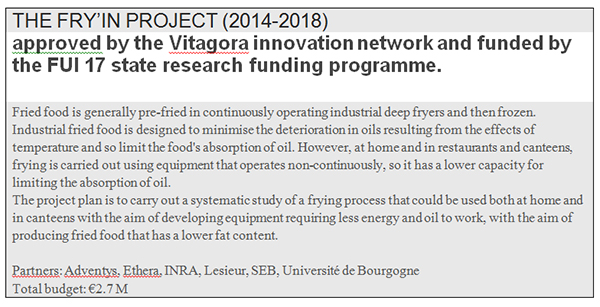Software simulating oil absorption has been developed and tested. It reveals the dynamics of oil penetration into food according to the level of damage in the tissues and cooling conditions (see also this news). These data open the way to new strategies for developing low-fat fried products.
Fries, nuggets, crisps, fritters and other fried products account for between 10 and 25% of the food eaten every day in France. People might like the taste, but these products are widely criticized for their high fat nutritional profile and their damaging effects on health. Companies today are trying to market lower fat products, while keeping the same texture and taste.

Understanding how oil absorption works
Contrary to preconceptions, fried food does not absorb oil when it is immersed in it, but only when it is taken out. Fries that make contact with oil are not yet full of fat: the water vapour on the surface creates high pressure, preventing oil from being absorbed. It is only when fries are removed from the oil, when they cool down, and the water condenses, that they act like a sponge, absorbing oil by capillary action and negative pressure. This has been shown by scientists studying dehydrated slices of potato soaked in hot oil with UV fluorescence microscopes.
These results have been achieved thanks to imaging equipment set up at the SOLEIL synchrotron (DISCObeamline, TELEMOS setup), revealing both the shape and defects of the potato tissues, and also the direction taken by the oil when it makes contact with the food.
Incorporating the findings into simulation software
The images obtained were used to build a three-dimensional model that can simulate the absorption of oil in food according to the amount of damage in the tissues.
It appears that the way the oil filters through the cells is a highly variable process in space, but also in time: it is almost instantaneous in the cells on the top layer and very slow in the second layer. It is not the quantity of oil in which the food is immersed that influences the depth or width of absorption, but the quality of the tissues in the food: everything depends on whether the cells are damaged and contain "wells" or "channels" across the tissues.
Developing new technological solutions to make lower fat products
Using the simulation tool that has been developed and tested, we can now reproduce the absorption profiles and kinetics of a very large number of products. We also need to know the three-dimensional structures and the cooling conditions of the product to be tested.
On the basis of these data, new production strategies can be developed to reduce the quantity of oil absorbed by fried food. For example, it has been shown that, despite a higher level of tissue damage, industrial frozen food tends to absorb less oil due to the low number of defects on the surface of the fries (less than 10 for every centimetre of fries), where starch has been turned into gelatine before frying.
Developing the future possibilities of the results is continuing with the Fry'In project (see below), as well as confidential partnerships with food manufacturers.

